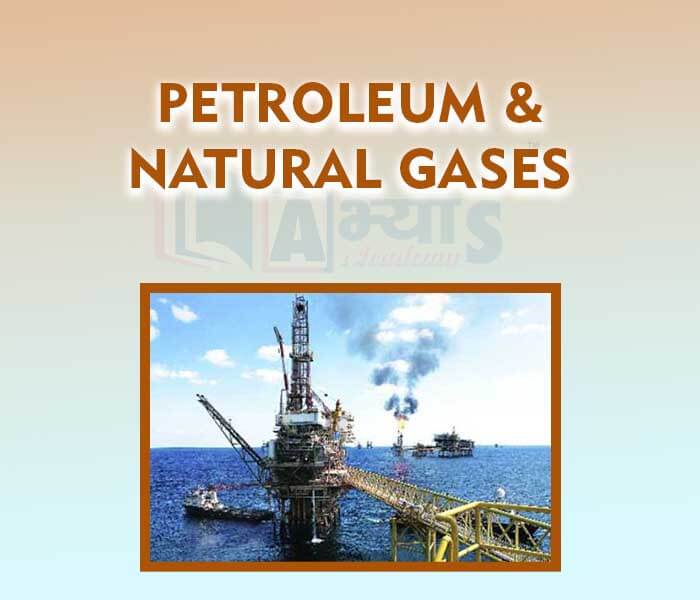Petroleum and Natural Gas







Petroleum and Natural Gas
Petroleum and Natural Gas: Petroleum and natural gas were formed from the remains of tiny marine organism that died millions of years ago.
Process of formation of petroleum and natural gas: Tiny marine organisms died and settled on the ocean floor. With passage of time, this layer of dead organisms were covered beneath sediments. Enormous heat and pressure transformed the remains to petroleum and natural gas. Rising through porous rocks like sandstone, petroleum and natural gas reached a layer of impermeable rock and trapped below it. Petroleum and natural gas are extracted by drilling through the impermeable rocks. Petroleum is a complex nature of solid, liquid and gaseous hydrocarbon. The process of separating various constituents of petroleum is known as refining and carried out in refinery. It is heated to 400°C and introduced in fractionating column. Vapours of petroleum rise inside the fractionating column cool and condense at different heights, depending on their boiling paints and collected in different trays.
Products obtained are:
Natural Gas: It is a naturally occurring hydrocarbon gas mixture consisting mainly of methane and some other hydrocarbons as well. Uses of natural gas:
Refining of petroleum : Petroleum is a mixture of several hydrocarbons. It is a foul - smelling brown black liquid. It also contains water, salt and rocky materials. It can not be used in this crude form either as a fuel or as a basic material to produce other useful components. Before being put to use, it has to be purified and refined. The process of separating the various components of petrol from one another is known as the refining of petroleum. This is done by a process called fractional distillation which is based on the fact that the different components of petroleum have distinctly different boiling points. They are seprated in a large fractionating column. Crude oil is pipped to the refinery from a well. It is washed with acid and alkali solutions to remove the basic and acidic impurities respectively. Crude oil is now heated about 673 K and fed at the base of fractionating column. All the components of expect asphalt are in the vapour state. As the mixture of hot vapours rise up in the column, it begins to cool. The components with the highest boiling point condense later.
The components obtained at different heights in order from the bottom are asphalt, lubricating oil, paraffin wax, fuel oil, diesel, kerosene, petrol and petroleum gas.
Products obtained on fractional distillation of crud :
Read the following statements and mark the correct ones from the given options.
| |||
| Right Option : D | |||
| View Explanation | |||
Dead organisms are transformed into petroleum and natural gas in ______________________ | |||
| Right Option : A | |||
| View Explanation | |||
Match the following:
| |||||||||||||
| Right Option : D | |||||||||||||
| View Explanation | |||||||||||||
Students / Parents Reviews [10]
Abhyas is a complete education Institute. Here extreme care is taken by teacher with the help of regular exam. Extra classes also conducted by the institute, if the student is weak.

Om Umang
10thA marvelous experience with Abhyas. I am glad to share that my ward has achieved more than enough at the Ambala ABHYAS centre. Years have passed on and more and more he has gained. May the centre flourish and develop day by day by the grace of God.

Archit Segal
7thAbout Abhyas metholodology the teachers are very nice and hardworking toward students.The Centre Head Mrs Anu Sethi is also a brilliant teacher.Abhyas has taught me how to overcome problems and has always taken my doubts and suppoeted me.

Shreya Shrivastava
8thI have spent a wonderful time in Abhyas academy. It has made my reasoning more apt, English more stronger and Maths an interesting subject for me. It has given me a habbit of self studying

Yatharthi Sharma
10thAbhyas Methodology is very good. It is based on according to student and each child manages accordingly to its properly. Methodology has improved the abilities of students to shine them in future.

Manish Kumar
10thMy experience with Abhyas is very good. I have learnt many things here like vedic maths and reasoning also. Teachers here first take our doubts and then there are assignments to verify our weak points.

Shivam Rana
7thIt has a great methodology. Students here can get analysis to their test quickly.We can learn easily through PPTs and the testing methods are good. We know that where we have to practice

Barkha Arora
10thIt was good as the experience because as we had come here we had been improved in a such envirnment created here.Extra is taught which is beneficial for future.

Eshan Arora
8thMy experience was very good with Abhyas academy. I am studying here from 6th class and I am satisfied by its results in my life. I improved a lot here ahead of school syllabus.

Ayan Ghosh
8thOne of the best institutes to develope a child interest in studies.Provides SST and English knowledge also unlike other institutes. Teachers are co operative and friendly online tests andPPT develope practical knowledge also.
